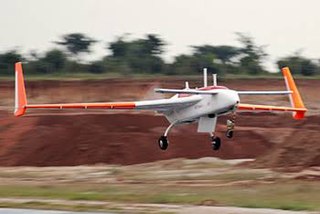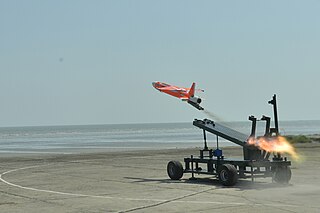
Hindustan Aeronautics Limited (HAL) is an Indian public sector aerospace and defence company, headquartered in Bangalore. Established on 23 December 1940, HAL is one of the oldest and largest aerospace and defence manufacturers in the world. HAL began aircraft manufacturing as early as 1942 with licensed production of Harlow PC-5, Curtiss P-36 Hawk and Vultee A-31 Vengeance for the Indian Air Force. HAL currently has 11 dedicated Research and development (R&D) centres and 21 manufacturing divisions under 4 production units spread across India. HAL is managed by a board of directors appointed by the President of India through the Ministry of Defence, Government of India. HAL is currently involved in designing and manufacturing of fighter jets, helicopters, jet engine and marine gas turbine engine, avionics, software development, spares supply, overhauling and upgrading of Indian military aircraft.

Akash is a medium-range mobile surface-to-air missile (SAM) system developed by the Defence Research and Development Organisation (DRDO) and produced by Bharat Dynamics Limited (BDL). Surveillance and Fire control radar, tactical control and command center and missile launcher are developed by Bharat Electronics (BEL), Tata Power Strategic Engineering Division and Larsen & Toubro. The Akash missile system can target aircraft up to 45 km (28 mi) away. It has the capability to neutralise aerial targets like fighter jets, cruise missiles and air-to-surface missiles. It is in operational service with the Indian Army and the Indian Air Force.

The GTRE GTX-35VS Kaveri is an afterburning turbofan project developed by the Gas Turbine Research Establishment (GTRE), a lab under the Defence Research and Development Organisation (DRDO) in Bengaluru, India. An Indian design, the Kaveri was originally intended to power production models of the HAL Tejas Light Combat Aircraft (LCA) developed by Hindustan Aeronautics Limited. However, the Kaveri programme failed to satisfy the necessary technical requirements or keep up with its envisaged timelines and was officially delinked from the Tejas programme in September 2008.

Nirbhay is a long range, all-weather, subsonic Cruise Missile designed and developed in India by the Aeronautical Development Establishment (ADE) which is under Defence Research and Development Organisation (DRDO). The missile can be Launched from Multiple Platforms and is capable of carrying conventional and nuclear warheads. It is currently deployed in limited numbers in Line of Actual Control (LAC) during standoff with China.

The DRDO Nishant - is an unmanned aerial vehicle (UAV) developed by India's Aeronautical Development Establishment (ADE), a branch of Defence Research and Development Organisation (DRDO) for the Indian Armed Forces. The Nishant UAV is primarily tasked with intelligence gathering over enemy territory and also for reconnaissance, training, surveillance, target designation, artillery fire correction, damage assessment, ELINT and SIGINT. The UAV has an endurance of four hours and thirty minutes. Nishant has completed development phase and user trials.
Aeronautical Development Establishment is a laboratory of India's Defence Research and Development Organisation. Located in Bangalore, its primary function is research and development in the field of military aviation.

The DRDO Rustom is a medium-altitude long-endurance unmanned air vehicle (UAV) being developed by Defence Research and Development Organisation for the three services, Indian Army, Indian Navy and the Indian Air Force of the Indian Armed Forces. Rustom is derived from the NAL's LCRA developed by a team under the leadership of late Prof Rustom Damania in the 1980s. The UAV will have structural changes and a new engine.
The DRDO Fluffy was a target drone designed and developed by the Defence Research and Development Organisation's Aeronautical Development Establishment (ADE) in Bangalore in early 1970s for use by the Indian Armed Forces.

Ghatak is an autonomous jet powered stealthy unmanned combat air vehicle (UCAV), being developed by Aeronautical Development Establishment (ADE) of the Defence Research and Development Organisation (DRDO) for the Indian Air Force. The design work on the UCAV is to be carried out by Aeronautical Development Agency (ADA). Autonomous Unmanned Research Aircraft (AURA) was a tentative name for the UCAV. Details of the project are classified.
The Indian Air Force has been undergoing a modernization program to replace and upgrade outdated equipment since the late 1990s to meet modern standards. For that reason, it has started procuring and developing aircraft, weapons, associated technologies, and infrastructures. Some of these programs date back to the late 1980s. The primary focus of current modernization and upgrades is to replace aircraft purchased from the Soviet Union that currently form the backbone of the Air Force.
Ulka is an air-launched expendable target drone of India.

Barak 8, also known as LR-SAM or MR-SAM, is an Indo-Israeli jointly developed surface-to-air missile (SAM) system, designed to defend against any type of airborne threat including aircraft, helicopters, anti-ship missiles, and UAVs as well as ballistic missiles, cruise missiles and combat jets. Both maritime and land-based variants of the system exist.

Sudarshan is an Indian laser-guided bomb kit, developed by Aeronautical Development Establishment (ADE), a DRDO lab with technological support from another DRDO lab Instruments Research and Development Establishment (IRDE), for the Indian Air Force (IAF).
The Imperial Eagle is an Indian light-weight mini-unmanned aerial vehicle (UAV) developed by the Aeronautical Development Establishment, National Aerospace Laboratories and supported by private vendors. Its primary users will be the National Security Guard and the military services.

The DRDO Abhyas is a high-speed expendable aerial target (HEAT) being built by the Aeronautical Development Establishment (ADE) of the Defence Research and Development Organisation (DRDO) for the Indian Armed Forces.

The Tactical Airborne Platform for Aerial Surveillance-Beyond Horizon-201 or TAPAS BH-201 is a medium-altitude long-endurance (MALE) unmanned aerial vehicle (UAV) being developed in India by Aeronautical Development Establishment (ADE) on the lines of General Atomics MQ-1 Predator.
The DRDO Smart Anti-Airfield Weapon (SAAW) is a long-range precision-guided anti-airfield weapon developed by India's Defence Research and Development Organisation (DRDO). It is designed to be capable of engaging ground targets with high precision up to a range of 100 kilometres (62 mi).

The HAL Combat Air Teaming System (CATS) is an Indian unmanned and manned combat aircraft air teaming system being developed by Hindustan Aeronautics Limited (HAL). The system will consist of a manned fighter aircraft acting as "mothership" of the system and a set of swarming UAVs and UCAVs governed by the mothership aircraft. A twin-seated HAL Tejas is likely to be the mothership aircraft. Various other sub components of the system are currently under development and will be jointly produced by HAL, National Aerospace Laboratories (NAL), Defence Research and Development Organisation (DRDO) and Newspace Research & Technologies.

The Vertical Launch – Short Range Surface to Air Missile, or VL-SRSAM is a quick reaction surface-to-air missile developed by the Indian Defence Research and Development Organisation (DRDO). During mid-course flight, the missile uses fibre-optic gyroscope based inertial guidance mechanism while in terminal phase uses active radar homing. With lock on before launch (LOBL) and lock on after launch (LOAL) capability, the missile receives mid-course update via datalink. VL-SRSAM intended to replace older Barak 1 surface to air missile system onboard Indian Navy warships. It will also be used as short range air defence system for Indian Air Force.

The Very Short Range Air Defence System, or VSHORADS, is a fourth generation, man-portable air-defense system (MANPADS) developed by Research Centre Imarat (RCI),a research lab under Defence Research and Development Organisation (DRDO), located in Hyderabad. Multiple DRDO laboratories along with Indian Industry Partners are participating in the project. It is designed for anti-aircraft warfare and neutralising low altitude aerial threats at short ranges.
















